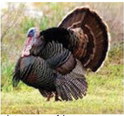Keeping tabs on Arkansas turkeys

Keeping tabs on Arkansas turkeys
AGFC asks hunters to track birds in annual survey
Arkansas Game & Fish Commission LITTLE ROCK — Hunters can help the Arkansas Game and Fish Commission track hunting effort and success throughout turkey season this spring by signing up to be a part of the annual Spring Gobbler Hunting Survey.
It’s free to participate and your responses will help shape important aspects of wild turkey management in Arkansas.
The spring turkey hunting survey has been in place since 2007 to gather information on hunter activity, gobbling activity, turkey observations and hunting success throughout turkey season. Volunteers record data from each hunt in a small booklet provided by the AGFC and send the results to be analyzed at the end of the hunting season.
Biologists then compile all the data to identify trends in hunter participation and satisfaction and provide a report for all hunters to compare notes.
With days getting longer and hopefully warmer, many turkey-hunting fanatics already have reorganized their hunting vest so many times they are beginning to lose patience.
Some die-hards will be scouting for this year’s turkey-hunting prospects in the next few weeks, if they haven’t started already.
This scouting data also is very important to the survey, as it helps biologists see what most hunters are experiencing in the woods throughout the state all spring.
“It gives us a snapshot of how each season progresses and helps show trends in gobbling activity, flock breakup and other factors that influence turkey hunting,” said Jeremy Wood, turkey program coordinator for the AGFC. “We’ll send the results of the survey out later in the year, so both managers and hunters can look at how the season was with some perspective.”
Participation in the survey has waned in recent years, but Wood hopes more hunters will take advantage of this tool to help the AGFC manage turkeys and turkey hunting opportunities in Arkansas.
“We’re only looking to identify the eco-region and whether hunters were on private or public land, so hunters can speak freely about their experiences without worrying that they’re giving away any secrets,” Wood said.
It’s no secret that wild turkey populations have declined throughout the southeastern United States in the last decade. Even turkey hunting destinations like Missouri have seen as much as a 17 percent decline in turkey harvest from spring 2017 to spring 2018. Arkansas’s turkey population has seen the same decline, and biologists are working to reverse the trend. It may be easy to pick out one or two obvious things that have changed since Arkansas’s turkey hunting heyday in the early 2000s, but many factors play into turkey population health. Overall, declines in high-quality nesting and brood-rearing habitat have been a major player in the downward trend, but poor hatches from cold, wet springs, declining demand for fur, supplemental feeding of wildlife during the spring which congregates nest predators in certain areas while hens are trying to nest and potential disease transmission, all may be playing a role in local areas contributing to statewide declines.
“We are conducting other surveys, such as brood surveys and telemetry studies that will look more in-depth into population characteristics, but this survey is designed around hunter participation, expectations and satisfaction,” Wood said.
Email Wood at jeremy.
wood@agfc.ar.gov or call 800-364-4263 to participate in the survey. Hunting journals will be mailed within the next few weeks.

From Randy Zellers


Share